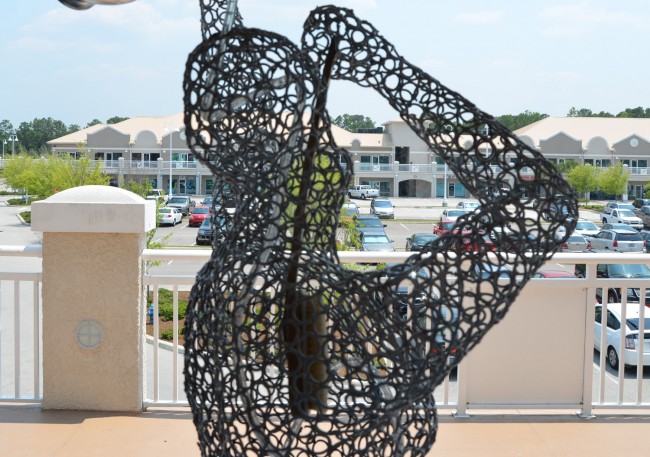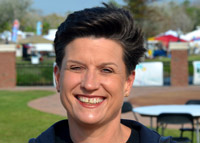
Art, whether taught to children, viewed in a gallery, or critiqued in a college classroom, should inspire its audience to respect and learn from the self-expression of others. With that guiding principle, people active in the Palm Coast arts scene are finding strength in numbers as they move to form an arts alliance, still unnamed, to showcase the talent and creativity in our area.
“The goal of the more than 50 arts and culture organizations is to network, share information, and make an impact on the community,” says Ann Delucia, president of the Flagler County Art League. The art league, Flagler Playhouse, and the Palm Coast Arts Foundation, among others, are working to establish the Palm Coast/Flagler area as a world-class forum for the performing, visual, literary and graphic arts.
A nearby model for that objective is the Volusia County Cultural Alliance, “a non-profit network of community cultural organizations, individual artists and local businesses, committed to the development of the arts in Volusia County and focused on the enhancement of the quality of life for our county’s residents and visitors,” according to that group’s website. The St. John’s Cultural Alliance in St. Augustine and its monthly art walks are also an inspiration.
“Some of us want to create a similar organization here and some do not—they just want a loose network to share arts and culture events,” Delucia says. One conspicuous absence, for example: the Flagler Auditorium. Efforts to bring people together can also earn the ire of those they’re supposed to be helping: an artist’s ego is a notoriously flammable thing, with the barest slight, real or imagined, blinding it to heaps of praise and profit. In something of a truce among the arts organizations, the Palm Coast-Flagler initiative has, at least for now, been taken over by the Tourist Development Council of the Chamber of Commerce.
“No one wants to be told by another arts organization what to do,” Delucia says. “People fear for their own turf.”
Pat Love, president of the Flagler Playhouse, agrees that fears over turf conflicts were resolved by letting the Tourist Development Council take charge–not so much the council’s nine members as its administrative director: Georgia Turner, who combines an enthusiasm for the arts with a permanently positive disposition that brooks no partisanship. Love is convinced that the various groups will join together for the greater good, especially when it comes to financial issues. “This alliance can come forward with one unified voice,” says Love. “All our arts organizations have limited budgets, marketing, and advertising. If we are able to share volunteers and other resources, maybe down the road we could stage a full, week-long arts festival.”
There’s interest in creating a master calendar, so events don’t conflict with each other. There’s support from the real estate community, led by Sam Perkovich of ParkSide Reality, who is president of the Palm Coast Arts Foundation.

Though there was not a lot of time for networking, Delucia says the participation of the arts organizations was crucial. “We want to let the community know we’re here. This will not only broaden arts in the community but also outside, in regard to tourists,” Delucia says. For that reason, working with the Hospitality Alliance is essential.
When the Tourist Development Council developed its strategic plan from 2012 to 2013, it concluded that the arts are the niche market where there is the most opportunity for growth, says Turner. “The alliance came out of a need of the community to communicate,” Turner says. “This is true for the hospitality industry and the cultural and arts community. Our mission is to fill hotel rooms and have activities for members. I just want to put heads in beds.”
All of the local arts organizations were invited to a meeting shortly after the gathering of the Hospitality Alliance. The tourism council surveyed the arts groups in attendance, as well as those who had chosen not to participate, to assess their level of interest in forming a similar alliance. The findings pointed to the need for an arts alliance that would meet in conjunction with the Hospitality Alliance, Turner says. For some, a little cajoling was needed. “There’s always resistance when it comes to anything new. In any community, especially a smaller one like ours, it’s easy to get caught up in your own business, whether it’s a hotel or an art gallery, and not be able to see outside,” says Turner. But she was encouraged by the turnout at a gathering at Carrabbas in January, where many groups appeared unexpectedly, saying they, too, wanted to be a part of an alliance.
On Thursday, the arts alliance and the Hospitality Alliance will meet for a networking session. It’s part of the tourism council’s quarterly strategy meetings (this time at the Flagler Playhouse, beginning at 1 p.m.). One agenda item will be the question of what the alliance should call itself. “Do we call ourselves a cultural, historical (with groups like the Palm Coast Historical Society), or an arts alliance? ” Turner asks. “In any event, the arts are a huge and viable part of the community. We’re a small community to have such quality art. We should remember to be fortunate for what we have.”
The Hollingsworth Gallery—which rents space to City Repertory Theater, owned and directed by John Sbordone, the former Playhouse director, whose non-traditional vision matches J.J. Graham’s—is a good example of one arts organization willing to play with unusual bedfellows. For that reason, Turner picked Graham to be involved in the marketing strategy for the alliance. Of his own experience within the Palm Coast arts scene, particularly with the art league’s more traditional offerings, Graham says, “Art is competitive, so there’s friction sometimes. A lot of what we were doing was in the opposite direction. But we’re past that. Ann Delucia is really easy to work with.”
Graham stepped out of his gallery to curate the halls and bar of the Pine Lakes Grand Club this past January–for one night only. The lively exhibit resulted in such a large turnout that the club asked him to keep the work up for another two months. Another creative collaboration took place last July between Palm Coast Bikes and the Gargiulo Art Foundation’s bike-themed art and poetry show, which Graham curated at Hollingsworth. The show opened alongside Palm Coast’s Arts and Recreation’s third annual “Tour De Palm Coast.” Palm Coast Bikes donated bicycles that Gargiulo ran along the outside walls of City Marketplace, forming a path from Hollingsworth to the art league.
“I think the people who did the original Palm Coast city planning weren’t really creative,” Graham says. “We have to create a climate that will make people want to retire here. Art will bring more people to Palm Coast.”
According to Graham, the stagnant Flagler economy may be just the kick that a vibrant and viable art scene needs. “Right now the economy is kind of in limbo, but the artists can play off that,” he says. “They can take advantage of that slow life pulse. There’s a history of patterns of great artists moving in during a downturn. It’s like in the movie, ‘The Cool School,’ the real-life story of a bunch of beatnik artists who moved to an art-austere LA during tough times, and opened the famous Ferus gallery of the ’50s and ’60s. They started their own brand of art-making and, over time, that area became a competitive scene for the arts.
“Great galleries are born in times of economic distress because the artists can afford space and they can get their feet under them,” Graham adds. “I would have never been able to get my gallery otherwise. That’s what I’d like to see happen here. By the time things start booming, we can survive.”
With that, Graham says the work being done by the Tourist Development Council is very important and he wishes them the best. But he adds a word of caution: Because of the egos that are inherent in the complex world of art, “They have their work cut out for them.”




























Leave a Reply